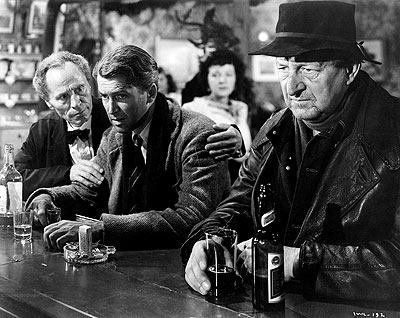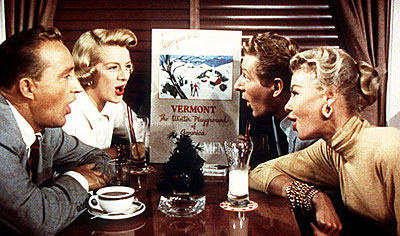It’s (less than) a Wonderful Life
Published on December 6th, 2012 in: Holidays, Movies, Over the Gadfly's Nest |I am about to share what I’m sure will be an unpopular opinion. I don’t care for It’s a Wonderful Life.

In case there’s anyone out there who hasn’t seen it, It’s a Wonderful Life is a 1946 film directed by Frank Capra and starring James Stewart, Donna Reed, and Henry Tavers. Stewart plays George Bailey, a building-and-loan manager who is thrown into crisis on Christmas Eve when his uncle (a co-worker) misplaces $8,000 that was meant to be deposited in the bank. Faced with criminal charges over the money and beset by lot of small emergencies at home, George contemplates suicide and wishes aloud that he’d never been born. A kindly angel named Clarence (Tavers) comes down and shows George what the world would be like if that were the case.
By the time Clarence and George meet, we’ve already seen in flashbacks how George found love and built a happy family with his wife (Reed), but how his attempts to leave his hometown of Bedford Falls and see the world were repeatedly thwarted. The rapacious Mr. Potter wants control of the town, and all that has stood between him and that goal was George’s building and loan. In a George-less world, Bedford Falls is now Pottersville, and many people whose lives George affected directly are miserable. Unsurprisingly, George chooses life at the end and everything works out when the townspeople he’d served so faithfully step up to the plate.
What could possibly be wrong with such a story, you may ask? Well, for a long time, the answer was “nothing.” Like many people, I grew up watching It’s a Wonderful Life every year around the holidays. It plays frequently in December, and would go into even heavier rotation, all along the dial, until Republic Pictures enforced their copyright in 1993. At some point, though, this became a big part of the reason for my disenchantment with it. I’ve just seen it too many times.
My real issue, however, is with the content of film. It’s very comforting to think that one person can make a difference, and as far as that goes, I agree that it’s true. At the same time, I don’t believe that we are only put here for other people. I also believe that the things we do for others have meaning whether or not anyone else could or would have done them
Once I reached a certain age, I became frustrated with watching George’s travel plans, both with and without his wife, repeatedly foiled. I wanted to see them get to see the world, to see the future of Bedford Falls finally secure, and the movie leaves all of that uncertain. I know that the takeaway is supposed to be that George’s community takes care of him in the same way that he took care of them. But somehow, it hits me as “Give and give, and then maybe, just maybe, when you’re the one in trouble, people will finally look out for you.”
A troubling question occurred to me in thinking about It’s a Wonderful Life: Why is George Bailey solely responsible for the fate of Bedford Falls, anyway? Is no one else in town—none of the other citizens, business people, or political leaders—accountable for keeping control from Mr. Potter? When it goes to this, the oeuvre of Joss Whedon rings more true to me than that of Frank Capra: one person might be able to change things, but they’re going to need some help from others.
Imagining for a moment that George hadn’t been born and others had saved the town; there are still things that would have been different without him. As a child, George saved Mr. Gower, the kindly pharmacist, from accidentally poisoning someone, and in Clarence’s vision, he is a tragically ruined ex-con. George also saved the life of his brother, who went on to save a ship full of servicemen as a Navy fighter pilot—something that he’s not there to do, of course, without George. These are things that he did, however, as a child. He could have done those things and still grown up to experience more of life outside of Bedford Falls.
Of course, those aren’t the only examples of George’s more individual interventions in people’s lives. But the other instances fail to hold the people in question, or other people who could have looked out for them, responsible for the outcome. The silliest one by far, though, is the idea that George’s wife Mary would never have married if he didn’t exist. She was played by Donna Reed, for goodness’ sake! I’m sure she would have found someone. I don’t hold with the idea that there’s only one person for anyone, anyway.
I’m not saying that Reed and Stewart didn’t have good onscreen chemistry. They did. I’m also not saying that it would have been better had George not been born. I’m just saying that It’s a Wonderful Life puts way too much pressure on its protagonist.

As an alternative holiday movie, I’ve grown fond of White Christmas. In it, Bing Crosby and Danny Kaye play entertainers who put on a musical to save the ski lodge owned by their former general. This film has lighthearted humor, amazing song and dance numbers, and a respect for soldiers that rings especially true today. Most importantly, in contrast to Life‘s fetishization of dull sacrifice, the message of White Christmas is that sometimes the best thing you can do for someone is to work with others and do what you love for their benefit.
While many critics find Frank Capra’s work cloying, I’m not saying that It’s a Wonderful Life is without merit. The framework in which it’s told was innovative for its time, and the performances are well, wonderful. It has the force of nostalgia and Christmas tradition behind it, and I’ve already acknowledged the appeal of its message. I don’t look down on the people who will re-watch and enjoy it this year. I just feel like I, personally, have grown away from it, and I’m not sure I’ll see it again. While both films emphasize the importance of doing for others, White Christmas sits better with the person I’ve become, and better represents the spirit of the holidays for me.
Time limit is exhausted. Please reload the CAPTCHA.